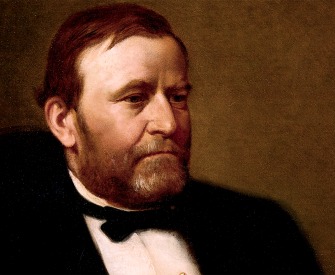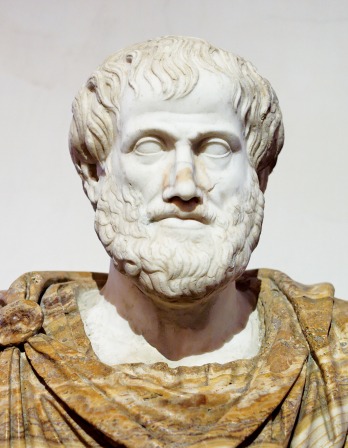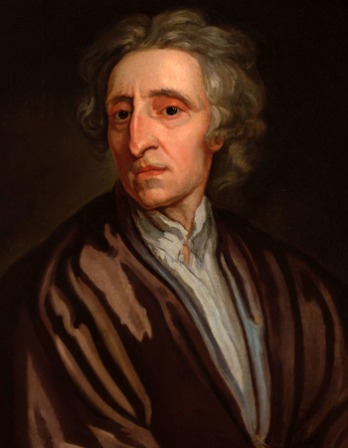Everybody says it; and what everybody says must be true.
—James Fenimore Cooper, 1844Hidden Agendas
On the timeless fascination with scandal and lessons from a career covering tabloid news.
By Ron Rosenbaum
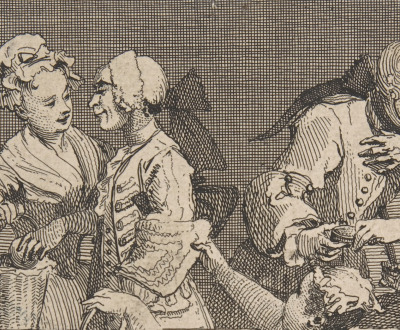
The Laughing Audience (detail), by William Hogarth, 1733. The Metropolitan Museum of Art, Harris Brisbane Dick Fund, 1932.
It is a fair summary of history to say that the safeguards of liberty have frequently been forged in controversies involving not very nice people.
—Felix Frankfurter
In taking up this issue of Lapham’s Quarterly, cast aside the notion that scandal requires the presence of celebrities. Yes, scandal may involve celebrities, but all too often scandals about people famous for being famous amount to little more than insipid self-promotion. Only occasionally when you crack the gilt carapace of the scandals of the rich and famous do you discover that they can illuminate the hidden secrets of the human heart.
Boris Kachka’s report on the world of public figures getting themselves into trouble admirably captures the formulaic nature of celebrity scandals, called “disgrace events” by a company that insures against the financial consequences of poor behavior, offering to make the risk of “celebrity downfall” as “quantifiable and reimbursable as that of floods and car crashes.”
To set aside celebrity scandals is not to diminish fascination with tabloid news, nor is it to dismiss interest in or discount its ability to open otherwise concealed aspects of human nature. In Roman myth Mount Olympus was a hotbed of scandals of the gods. It was a scandal when Vulcan, Olympian blacksmith and armorer, discovered Mars, god of war, coupling with the Olympian blacksmith’s wife, Venus, goddess of love. Vulcan trapped the two in a net—Love and War embracing—a mythological equivalent of TMZ. And it is often forgotten that Homer’s Iliad begins with a bitter tabloid squabble between Agamemnon and Achilles over a captive sex slave named Briseis, the outcome of which, the true “wrath of Achilles,” prolonged the Trojan War’s slaughter. These two piggish bullies fighting over a poor trafficked girl was a scandal with epic consequences.
The timeless fascination with scandal is recognized by Theophrastus circa 320 bc, who tells of a “newsmonger…who always has ready gossip” to be “noised all about the city.” By the nineteenth century,
William Hazlitt finds readers of newspapers “cannot take their eyes from the page…cannot live without” news of scandal. The best scandals, the ones most engaging to follow as they unfold, have a good deal in common with literature, and much great literature is generated by small-time, nonfamous scandals à la Flaubert’s Madame Bovary or Dreiser’s An American Tragedy. The texts in this issue of Lapham’s Quarterly attest that old scandals retain the shock of the new in the hands of a gifted storyteller. Consider Saint-Simon’s chronicle of Louis XIV’s scandalous love life, which “spread through Europe, confounded France, unsettled the state, bore evils that almost toppled him from the throne,” or James Thomson Callender’s scandalous but true charge that Thomas Jefferson kept “as his concubine one of his own slaves.” (An underestimation, as it turns out.)
In hindsight I find a goodly portion of my magazine writing over the past five decades has focused on scandal. I have dug into tabloid stories in the hope they might have greater value than the headlines let on. I also have had occasion to uncover scandals not yet exposed. What surprises me is how often there turned out to be hidden agendas that offer minatory lessons we as a culture never seem to learn. Of these, the most notorious was the story of the nude-posture-photo practice that plagued Ivy League and Seven Sisters colleges, as well as other prestigious schools across America, from the 1940s to the 1960s.
The scandal was this: for more than twenty years, first-year students at elite schools had been photographed naked, or nearly so—women at Wellesley were allowed to keep their underwear on. The practice had been sold as science to credulous elite institutions by W.H. Sheldon, a believer in the pseudoscience of eugenics (promoted before World War II by Nazi “master race” theorists). Sheldon, who directed an institute for physique studies at Columbia University, had a theory that he could determine personality from what was loosely called “posture”—actually bodily measurement ratios—that would reduce human nature to a matter of mathematics. Sheldon’s ectomorph, mesomorph, and endomorph categories put him in a Life magazine feature in 1951 and survive in common parlance, detached from their origins. The “posture photographs” were a vast eugenic project, with data accumulated to “control and limit the production of inferior and useless organisms,” according to a scholar studying Sheldon’s work. Not only did the uncovered scandal involve thousands of photographs of naked teenagers, some of whom became prominent adults (George H.W. Bush and Hillary Rodham among them), but it masked a hidden agenda involving eugenic pseudoscience.
I had my “posture” nude photo taken at Yale when I was a freshman, the enduring memory of which inspired me to look more deeply into the practice decades later, though I could not have imagined what I would discover. I cringe when I remember how compliant I was when I was summoned to the granitic fortress of Yale’s Payne Whitney gym and told to remove all my clothes and stand still, shivering from more than just the cold, while one of the white-clothed gym minions taped pins to the outlines of my body to (supposedly) later allow posture-photo analysts to record measurements of bodily ratios such as hip to waist for their ludicrous pseudoscientific analysis. Looking back, it was bizarre and ridiculous. We were not given the option to refuse. I was a naive suburban kid who thought this was just the way things were done in the august Ivy League.
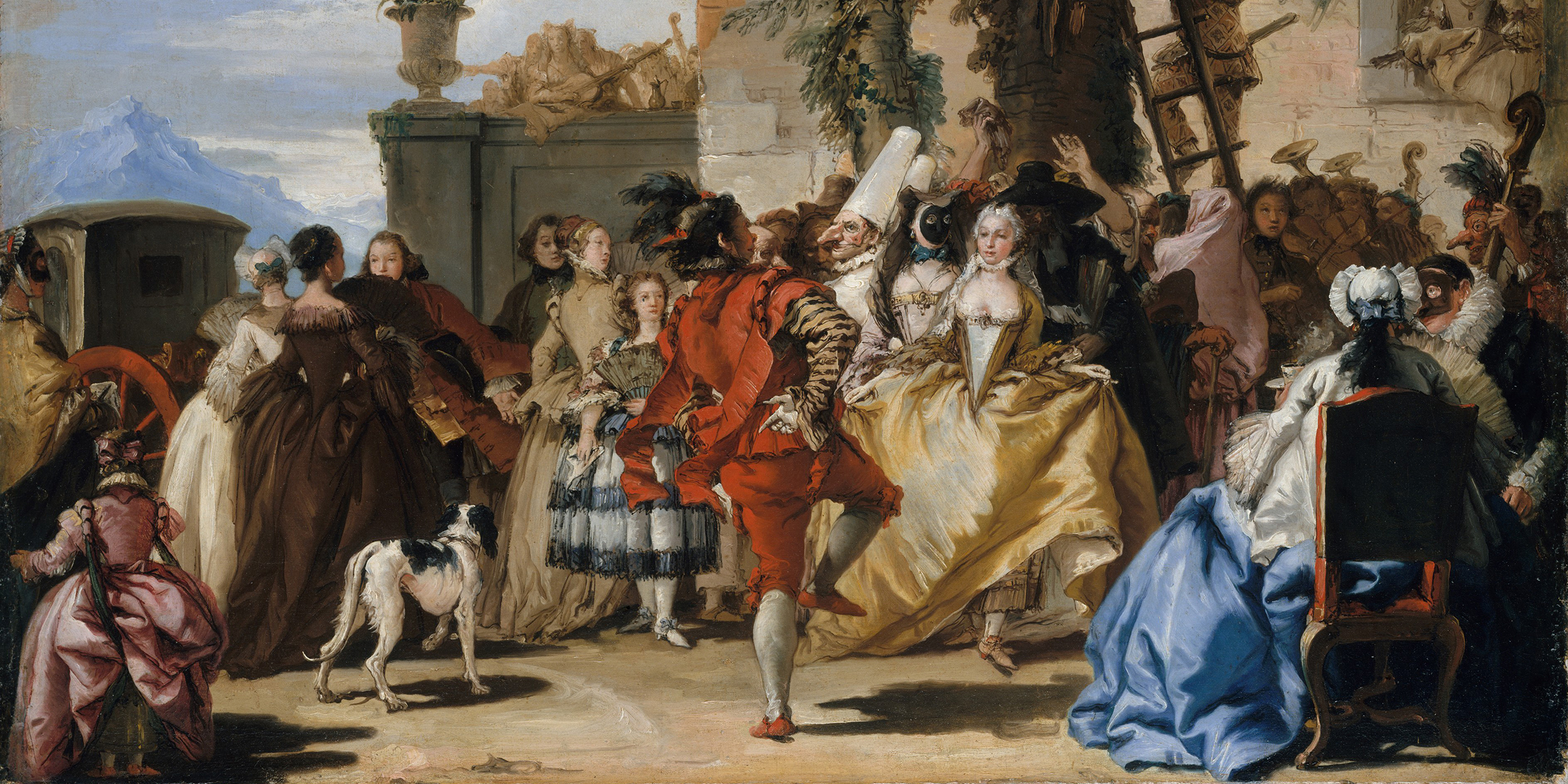
A Dance in the Country (detail), by Giovanni Domenico Tiepolo, c. 1755. The Metropolitan Museum of Art, gift of Mr. and Mrs. Charles Wrightsman, 1980.
The New York Times Magazine put my exposé on its cover in 1995 and bestowed upon it the headline the great ivy league nude posture photo scandal. After the story came out, the Times and I were deluged with queries from alumnae of women’s colleges still feeling abused and violated by the long-ago and arguably illegal process. (Most of the men didn’t complain, perhaps being more used to locker-room nudity.) A week ago, as I write this, I received an email from a woman who said she had been subjected to this process at the Yale-affiliated Gesell Institute and finally got the courage to see what had become of her nude photo and what the point of it all had been. Most of the photos had been dumped in a janitor’s closet in the Yale gym after the practice was abandoned. Other colleges forgot what it was really about (or never knew), and many of the nudes made a peripatetic journey to the anthropological collections of the Smithsonian’s National Museum of Natural History, where I located them. I was able to put my correspondent’s mind at rest: after my story was published, Yale and the Smithsonian burned some 75,000 of the posture photos.
Yale at least admitted it had been conned by Sheldon’s pseudoscience; some institutions, like Gesell and many of the women’s colleges, feared a lawsuit or the law (most of the women were under eighteen) and tried to deny they knew anything about the photos.
The ghosts of scandals past keep coming. The week after I got the letter from the woman still ashamed of her decades-old posture nude, I got a call about another scandal I had covered. The caller wanted to talk about a nearly forgotten death in the bleak, blisteringly hot desert town of Gila Bend, Arizona. My caller was seeking new evidence about the possibility that actor Burt Reynolds had been involved in a murder there.
Suspicions about Reynolds trace back to a mysterious 1973 desert noir, which I wrote about for Esquire. The incident came to my attention by way of the often reviled New York Post. (The paper is the fount of many tabloid scandals.) The Post reported the death of twenty-six-year-old David Whiting at the Travelodge Motel in Gila Bend during the production of a Hollywood film. Suspecting there was something more to the story, I got on a plane to Arizona, drove a rental through the desert, and checked in at the Travelodge.
The dead man, formerly a Hollywood-based entertainment reporter for Time magazine, had become obsessed with British actor Sarah Miles, just after Vogue had named her one of the three most beautiful women in the world. After three years of peculiar contact with Miles, Whiting secured a position as her business manager. He had traveled with her to Gila Bend, where the run-down Travelodge was the headquarters for a movie in which Miles and Reynolds costarred (the forgettable film was called The Man Who Loved Cat Dancing). Whiting, who came to view Miles as a Fitzgerald heroine, made himself annoying to everyone involved in the production, including Miles, and developed a bad case of jealousy focused on Reynolds. One night there was a fight in Miles’ and her nanny’s rooms, and Whiting, who popped quaaludes, may have physically assaulted one or the other. Later that night Whiting died bleeding from a “star-shaped wound” on his head, as the local coroner called it. Suspicion was that the star-shaped wound was caused by a star: macho Burt coming to the women’s defense and maybe knocking the back of the kid’s head into a wall.
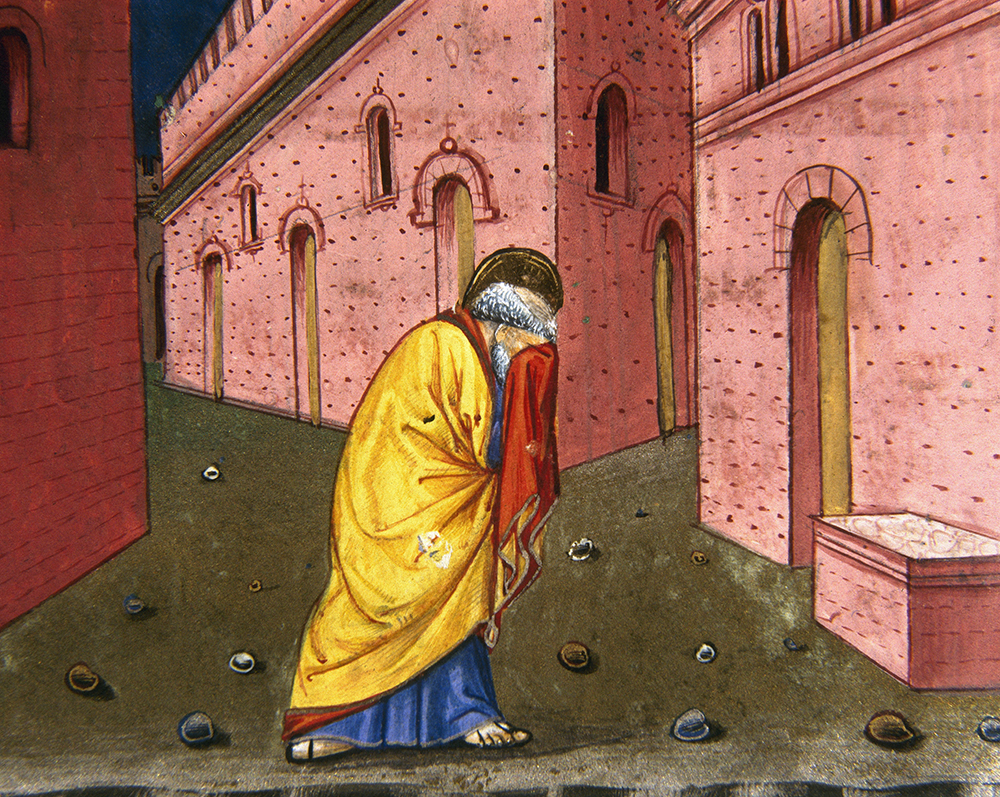
Saint Peter realizing he has thrice betrayed Jesus, miniature from the Leggendario Sforza-Savoia, by Cristoforo de Predis, 1476. © Album / Art Resource, NY.
Morbidly, I stayed in what had been the dead man’s motel room with the notion it would give me some perspective, and in fact I found that in the room’s Gideon Bible, passages referring to his namesake, David, had been underlined, which I suspected he might have done as he was dying. I covered the inquest and investigated Reynolds’ alibi. (He said he had been in his room getting a massage; I interviewed the masseuse.) Reporters from England and other foreign parts were swarming over the Travelodge—as well as Whiting’s mother, who was justly angry at the way her son’s death had been handled by Hollywood big shots, who fruitlessly tried to cover up the involvement of their stars. “I am really not interested in sitting on the griddle,” the film’s producer reproved me when I asked impertinent questions. The death was later ruled an overdose. Because of things I learned after writing my report on the case, I came to believe Reynolds’ masseuse alibi. But as is often the case with the most interesting scandals, you never learn the whole truth.
My reporting didn’t always focus on love and murder. I’ve also covered literary and political scandals, chief among them Watergate, which grows for me in memory. I spent a year living in Washington, DC, during the Watergate scandal, with official White House correspondent credentials. I was in the East Room of the White House at the climax of it all, standing a few yards away from just-resigned Richard Nixon as he delivered a weepy tribute to his mother before shuffling out the back door to a waiting helicopter, which took him to a jet and exile in California.
But the real scandal of Watergate was a media scandal. Most journalists and historians bought into the claim that, yes, Nixon had covered up the Watergate break-in—or tried to—but he hadn’t ordered it. The few of us who stayed behind to study closely the tapes and documents, only belatedly released, found the key Nixon quotes and the key Nixon motive. The president claimed he ordered the cover-up for supposedly noble reasons—to protect overzealous underlings. Most observers accepted the story throughout the Woodward and Bernstein investigations. No one had answered the question: What was the motive for the break-in?
I believe it was much like the motive for Trump’s Ukraine scandal: the concern about the upcoming 1972 election and the willingness to cross the line for an advantage. We now know that Nixon believed that, inside the Democratic National Committee headquarters in the Watergate office annex, inside DNC chairman Larry O’Brien’s office, O’Brien possessed documentary proof of Howard Hughes’ illicit funding of Nixon. (O’Brien had previously been a close aide of Hughes.) The so-called Hughes loan scandal had caused Nixon to lose his race for the California governorship in 1962. Now, once again, Hughes haunted the president with guilt and fear and caused him to harass and harangue his minions to get whatever it was O’Brien was holding in his office at the Watergate.
A study of the earliest tapes shows the real smoking gun was Nixon’s implicit admission that he ordered the break-in, and that his later denial that he did so was merely, as he put it, “my public line.” Once Nixon resigned, the media didn’t want to “pile on” and instead split the difference. It seemed everybody left town without answering the foundational question of why there had been a break-in. I suspect many of the journalists and historians knew Nixon had ordered it. Evidence of a cover-up was sufficient to get Nixon out of the White House, and then the conventional wisdom was to let the poor fellow alone, that his disgrace was bad enough. Explicitly or implicitly, he was allowed to get away with his “public line.” Nearly every journalist, and subsequently nearly every historian’s book on the scandal, professed belief in Richard Nixon’s final lie, the one he took to his grave.
Curiously—and, yes, coincidentally—it was while pursuing leads to Watergate mysteries that my paths crossed with a fellow named Danny Casolaro, who was at the time an independent researcher focusing on a mysterious character involved in the run-up to the Watergate break-in, a Brit with the enigmatic name of Woolsten-Smith. Seventeen years later I found myself in the middle of another scandal when Danny’s body was found in a blood-filled bathtub in a motel in Martinsburg, West Virginia, after telling everybody he knew in DC that he was going there to meet the source of the ultimate conspiracy, “the Octopus.” This was just a short time after he had showed me a draft of his story on the Octopus, one filled with tired conspiracy clichés he’d been pumped full of by shady characters who called themselves international arms dealers. Not unexpectedly, the conspiracy theories focused on finding a manuscript I’d already read and told him was sorely lacking in evidence, but the death of a journalist was no light matter. I found myself with a gaggle of other national-security and espionage writers sitting on the floor of ABC News’ DC headquarters, going through Danny’s big box of papers looking for clues, and failing to find anything new.
I eventually came to the controversial conclusion that Danny had killed himself, slit his wrists in the tub, as the only way to give validity to his conspiracy theory: the Octopus had to silence him. Having known Danny and having read the sacred Octopus manuscript, I concluded that the scandal beneath the scandal was that Danny was killed not by a conspiracy but by conspiracy theory.
I wish I had room to address a few more of my political scandals—the Mary Meyer–JFK love affair, for example. (I just took part in a podcast about their murders.)
Atruly sinister scandal I reported on concerned the serial killer Henry Lee Lucas. In the 1980s Lucas confessed to hundreds (the number eventually hit six hundred) of serial-killer-type murders, describing the crimes to Texas Rangers. He conned the Rangers into postponing his potential execution date (for a single killing he had been mistakenly convicted of) with his willingness to “clear” unsolved murders throughout America. This gave him years of electric-chair-postponing extended interviews about how and why he killed mostly women hitching along the interstates despite his provable presence halfway across the country at the time. Texas Rangers in charge gave him strawberry milkshakes and premium cable to watch in his cell. Lucas’ scam was initially exposed by some brave journalists and lawmen. I found a couple whose daughter had been murdered in Texas while Lucas, who claimed he did it, was in Florida. The couple, whom I met while they were hiding from vengeful lawmen whose bogus cases they had helped expose, were never satisfied with the much vaunted Texas Rangers, who had refused to look into the validity of his claims. Lucas had become a celebrity among lawmen who prided themselves on “solving” scores of murders through his willingness to confess to them. He eventually confessed that his confessions were fraudulent.
Everyone knows about everybody in Hollywood—who sleeps with whom, who doesn’t sleep, who does it standing on his head or in the dentist’s chair.
—Rock Hudson, 1982I also have had occasion to look at literary scandals. One of my favorites: the so-called Funeral Elegy case, wherein a Vassar professor claimed he had discovered a new (i.e., previously unrecognized) poem by Shakespeare and achieved brief national fame bragging about his brilliance with great humility. I doubted it and wrote columns attacking the attribution. Shakespeare could write on a lesser plane, occasionally badly, but not that bad sustained over six hundred platitudinous lines. The professor stuck to his guns for several years until British professor Brian Vickers, a preeminent Shakespeare scholar, demolished the claim by revealing the name of the person who actually had written it, causing the Vassar professor to write a grudging retraction.
What sets aside mere tabloid news from a more revelatory scandal that says something about human nature? On this point, I defer to a lesson learned from a wise editor. I had been doing a story for the pioneering journalism-criticism magazine More on a terrific character, New York icon Pat Doyle, homicide reporter for the tabloid Daily News.
Doyle liked to boast that he had covered some ten thousand murders over the course of his career. He was a much admired Irish wise-guy type with a taste for beer and stoicism. He loved to hang out in the fabled middle room of P.J. Clarke’s Third Avenue saloon and former speakeasy. He knew everybody and was not intimidated by anybody, because he was acutely aware we were all going to die, by homicide or not.
I was having trouble writing the story. I found myself on deadline and tormented, wrestling with Doyle’s formula for a “good murder.” It revolved around simple twists of fate, a double murder in a funeral home, for instance, a narrative that made it stand out from run-of-the-mill scandals.
So I found myself talking to my editor and asking him what was the heart of the Doyle story and his formula for a scandalous murder. He said, “John Milton.”
In the exordium to Paradise Lost, Milton defined his ambition: to “justify the ways of God to men.”
That’s what Doyle was doing over ten thousand murders, trying to figure out why one person died an untimely death and someone else didn’t—justifying “the ways of God to men.”
The hidden agendas of God.
